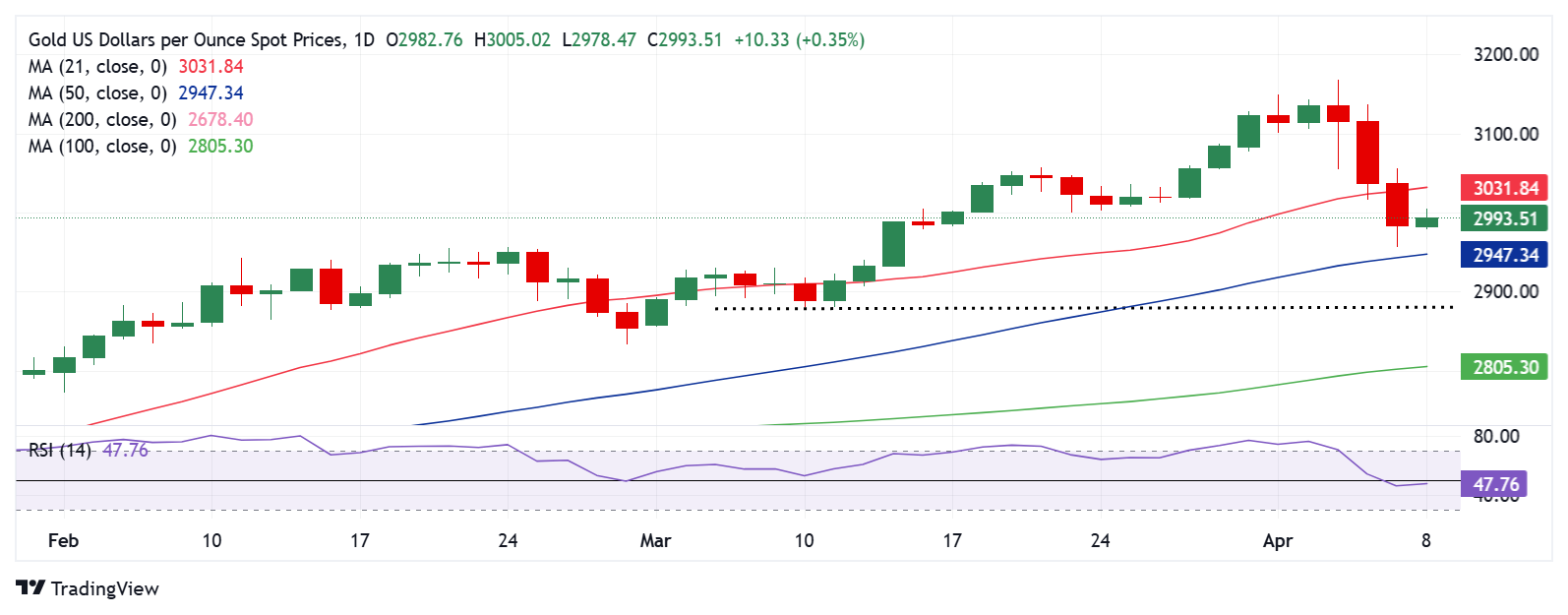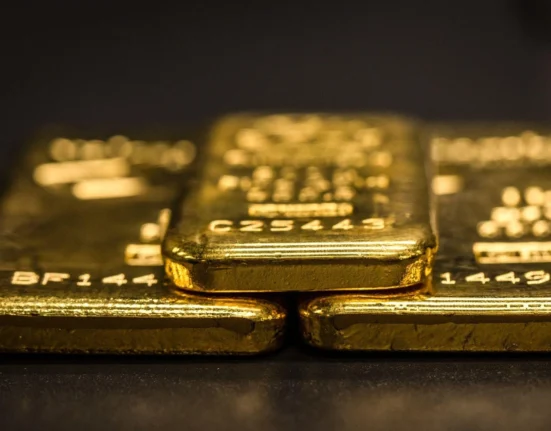- Gold price eyes a sustained move above $3,000 early Tuesday amid risk reset.
- Escalating US-Sino trade tensions, China’s support measures revive the US Dollar downside.
- Gold price is at a critical juncture above the 50-day SMA support at $2,947 while the RSI strives to turn bullish.
Gold price is building on its rebound from one-month lows of $2,957 early Tuesday, replicating the moves seen in Monday’s Asian trading. In doing so, Gold buyers retake the $3,000 threshold, but will they sustain the upswing amid escalating US-China trade tensions?
Gold price looks to global trade developments
Gold price is snapping a three-day correction as the US Dollar (USD) has come under renewed selling pressure while the US Treasury bond yields have paused their rebound from six-month troughs.
China’s efforts to step up lending to stabilize markets and a generalized recovery in risk sentiment revive the downside for the so-called safe-haven US Dollar. Meanwhile, Gold price also finds support from mounting concerns of an escalating trade war between the US and China.
The Chinese Commerce Ministry warned on Tuesday that it “firmly opposes and will take countermeasures if the US enacts additional 50% tariffs.” This came after US President Donald Trump on Tuesday threatened to impose a new 50% tariff, which will be cumulative alongside the US’s 10% across-the-board tariffs and targeted 34% “reciprocal” tariffs, which will take effect on Tuesday, April 9.
Additionally, increased expectations that the US Federal Reserve (Fed) could resume its interest rate-cutting cycle from May and deliver a total of five rate cuts in 2025 support the risk reset, while exerting renewed downward pressure on the dollar and US Treasury bond yields. Goldman Sachs now forecasts a total of 130 basis points (bps) in Fed rate cuts for 2025, up from 105 bps previously projected.
If the turnaround in global markets extends into the sessions ahead, the Greenback could see further weakness, leading to a sustained recovery in Gold price.
However, Gold buyers will likely remain wary of fresh developments on the global trade policies front, with the European Union (EU) preparing to impose retaliatory tariffs on US imports after having preferred negotiations.
Furthermore, as the US-China trade war escalates, China’s likely refusal to withdraw its latest 34% tariffs could reignite risk aversion across the board, fueling demand for the precious metal as a safe haven.
Gold price technical analysis: Daily chart

The tide seems to have turned against Gold price as the 14-day Relative Strength Index (RSI) closed Monday below the 50 level.
Currently, the RSI stays near 48.50, suggesting that bearish pressures persist despite the upswing.
However, Gold buyers remain hopeful so long as the 50-day Simple Moving Average (SMA) at $2,947 is defended.
A sustained break below that level will negate the near-term bullish potential, opening the door toward the $2,900 round figure.
The next relevant support levels are seen at the March 10 and 11 lows, at $2,880, and the 100-day SMA, at $2,805.
On the flip side, Gold price needs acceptance above the 21-day SMA at $3,022 on a daily closing basis for resuming the record rally.
Buyers will then look to the $3,050 psychological barrier, above which $3,100 will be tested.
Gold FAQs
Gold has played a key role in human’s history as it has been widely used as a store of value and medium of exchange. Currently, apart from its shine and usage for jewelry, the precious metal is widely seen as a safe-haven asset, meaning that it is considered a good investment during turbulent times. Gold is also widely seen as a hedge against inflation and against depreciating currencies as it doesn’t rely on any specific issuer or government.
Central banks are the biggest Gold holders. In their aim to support their currencies in turbulent times, central banks tend to diversify their reserves and buy Gold to improve the perceived strength of the economy and the currency. High Gold reserves can be a source of trust for a country’s solvency. Central banks added 1,136 tonnes of Gold worth around $70 billion to their reserves in 2022, according to data from the World Gold Council. This is the highest yearly purchase since records began. Central banks from emerging economies such as China, India and Turkey are quickly increasing their Gold reserves.
Gold has an inverse correlation with the US Dollar and US Treasuries, which are both major reserve and safe-haven assets. When the Dollar depreciates, Gold tends to rise, enabling investors and central banks to diversify their assets in turbulent times. Gold is also inversely correlated with risk assets. A rally in the stock market tends to weaken Gold price, while sell-offs in riskier markets tend to favor the precious metal.
The price can move due to a wide range of factors. Geopolitical instability or fears of a deep recession can quickly make Gold price escalate due to its safe-haven status. As a yield-less asset, Gold tends to rise with lower interest rates, while higher cost of money usually weighs down on the yellow metal. Still, most moves depend on how the US Dollar (USD) behaves as the asset is priced in dollars (XAU/USD). A strong Dollar tends to keep the price of Gold controlled, whereas a weaker Dollar is likely to push Gold prices up.







